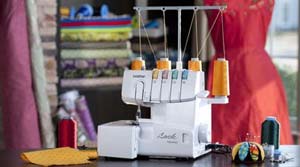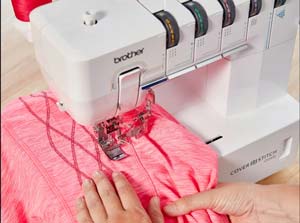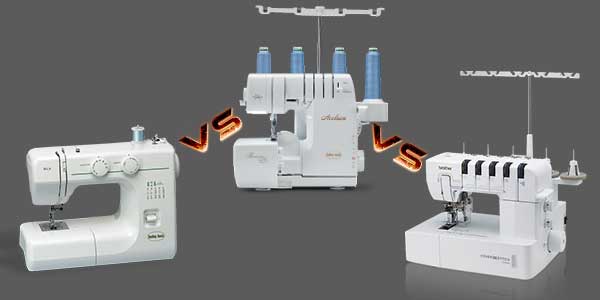Sewing Machine Vs Serger Vs Coverstitch: What Are The Key Differences?
Sometimes, taking a little ‘selfish’ me-time is important, if not necessary.
We become so busy with everyday life and everyone, we burn ourselves in the process. As a result, efficacy reduces depression barges in and you start feeling a lack of drive, compassion, and enthusiasm.
You put in a lot of time and effort making others happy, but what about yourself? Is there something you’re passionate and good at? Does doing a certain hobby gives you drive and self-fulfillment?
If you’re reading this article, then there is a good chance your that hobby is sewing. You love the quality time spent with yourself, the rhythmic sound of the machine, the display of creativity appearing through stitches and sews.
And that’s a good thing. That means you have a way to vent your pressure while enjoying yourself and crafting something meaningful in the process.
And now you’re thinking, which stitching machine will help you express your sewn works better. Which one is the right choice for your particular set of work?
In short, you want to know which one of the most popular machines are better, the Sewing machine vs Serger vs Coverstitch, right?
You’ve come to the right place. Only a noob will tell you one of them is the clear winner, that’s because they excel in different areas. Although they do the same job, depending on the application, one does certain jobs better than the other.
And we’ll give you a clear idea about that. So, keep reading.
Related Item: Most Popular Quilting Sewing Machine For Beginners
Table of Contents
A Brief Introduction To Sewing Machines

Instead of asking what a sewing machine is, the more appropriate question will be what does it do? Simply put, a sewing machine is a device that binds fabric together.
The machine contains one needle and option to attach one/two threads depending on your work. It is used to stitch and neaten seams. The basic sewing machine can produce straight or crisscross stitches for various length and width.
If you are interested in embroidery, a sewing machine is a must have, while having a serger or coverstock is optional. Obviously, you’ll need them from time to time, even do most of the work by them, but a sewing machine will facilitate you topstitching works and sewing buttonholes, zippers etc.
Now, how do you sew various fabrics on the sewing machine? You can use a straight stitch for non-stretch woven clothes. Conversely, you can use a zigzag stitch for stretch fabrics or rough edges.
Sewing machines aren’t just the basic type they once used to be. Nowadays, you’ll see electrical and computerized sewing machines. The feat you can achieve by these machines is incredible.
With the computerized machines, you can select one of many designs and it’ll automate the process. They also come with detailed guides and lessons you help you understand how a swing machine work.
A Brief Introduction To Serger Machines

Often called the ‘Overstitch’, the serger is an advanced type of sewing machine. It can cut and trim your seams as you stitch, which makes it both convenient and inconvenient, depending on your expertise.
Usually, a serger contains 3-5 bobbins in it. The number of bobbins indicates the number of threads it can work with. It forms a lockstitch using 3-5 different threads.
This machine especially works well with stretchy fabrics and lycra. It recognizes that stretchy fabrics need stretchy seams. It has a differential feed mechanism that allows the user to work on stretchy fabrics.
Also, the machine can attach elastic with the help of an elastic applicator. It has a sharp cutter that cuts the fabric whenever needed.
Learning the threading is a bit tricky and it may take some time to grasp it for a new user. If you have a budget, you can go for a self-threading serger. Always make sure you arrange the threads in the right order.
A Brief Introduction To Coverstitch Machines

The coverstitch machine will be a great addition to your sewing machine collection. The machine might seem complex from the outside, but it has basically one function. It sews hems on stretch clothes.
If you are wondering what a hem is, pull one of your t-shirts from the drawer. At the bottom of the shirt, you’ll find two straight stitches on the outside and interlocking stitches on the inside. If you pull the thread, you’ll see the stitches stretching. This is a hem design.
Usually, this machine is used for professional works. Since changing the threads are time-consuming, the Coverstitch is better for long, repetitive works. However, there are many sewing enthusiasts who keep a coverstitch to put professional, store quality hems on edges, sleeves, and necklines.
Sewing Machine Vs Serger Vs Coverstitch | The Differences
The Physical Look
Usually, you’ll be able to differentiate them by the number of needles and threads you can work with.
The Sewing Machine: The sewing machine comes with one needle and one/two threads. It usually comes with a longer neck and a simpler design.
The Serger: The Serger comes with 3-5 bobbins in which you can allocate the threads. That means you can work with 3-5 threads. Also, the machine comes with a longer neck.
The Coverstitch: A coverstitch machine looks a lot like a serger. It usually has two needles and facility to attach 2/3/4 bobbins. The bobbins are of different colors. In the first glance, the machine will look like an old model typewriter.
The Stitch Types
Since the needle number and the working principle are different, it’s only normal the stitch type will also be different.
The Sewing Machine: The traditional sewing machine uses topstitch, which is a basic yet necessary type of stitching. You can do straight and zigzag stitching in different lengths and width.
The Serger: The serger uses lockstitch. Usually, it is a more durable stitch and gives better stability to seams. The stitching needs 3-4 threads interlocking one another in an orderly and systematic way.
The Coverstitch: The coverstitch works more or less like the serger. It also uses several threads. However, it can only stitch hems. Sometimes they come as a part of serger machines.
The Uses
The three machines have different types and frequencies of uses. You might not need them all together on a daily basis, but they’ll help you complete your work independently for sure.
The Sewing Machine: Sewing machines are the most used machines, used for day to day sewing. You can stitch in different lengths and embellished designs, a great choice for decorative designs. It can facilitate most basic yet important functions like attaching buttons, zippers, making buttonholes, assembling two pieces of fabrics.
The Serger: The serger works faster than regular sewing machines. It specifies in seams and securing rough edges. It comes with several threads. The threads form an interlock to make a seam that won’t be torn easily. It can also finish rough edges and make rolled hem designs. The 4 thread serger can sew on stretch fabrics.
The Coverstitch: The coverstitch machine facilitates professional looking neatening on stitches. But their most important task is making two line hems on the bottom, sleeves, and neckline of a t-shirt.
What They Can’t Do
While they can each accomplish a set of works, what they can’t do is also significant. Because that will determine the level of independence you’ll have while you work.
The Sewing Machine: A sewing machine can do basic works, but when it comes to decorative stitching, it has limitations due to one needle. Not that it matters for most people, because you can still do a lot with the sewing machine. However, it will be tough to create seams that fit elastic fabric with this machine.
The Serger: On the other hand, the serger is a great choice for making seams. However, it cannot deliver basic functions like topstitching, attaching buttons, making buttonholes.
The Coverstitch: The coverstitch is a one trick pony actually. But that trick is used widely for making t-shirts, thus a necessary one. Naturally, it cannot make buttonholes, stitch buttons, or gather decorative stitches.
Pros Of Having A Sewing Machine Over A Serger
You’ve known about the machines and how they are different from one another. Now we’ll discuss how one machine can outperform the others, starting with the sewing machine.
No Electricity Cost: This applies to the non-electronic sewing machines only. Although more and more sewing machines are coming that run on electricity, there are still good quality manual sewing machines that are run by physical labor. It may sound vicious, but it’s actually fun.
Easy To Work With: It’s really hard to find someone who hasn’t seen a sewing machine in his entire life. Regardless of the country, everyone has seen one of these manual sewing machines at the very least. A lot of people who never did a needlework in their life know how a sewing machine work. Even if that’s not the case, learning and mastering it is easier than other machines.
Freedom And Flexibility: Working with sewing machine usually involves close monitoring and manual work. That’s why, it does what a proper hobby should do, engaging your mind and concentration. In the plus side, if a design goes wrong, you can instantly identify and rectify it.
Pros Of Having A Serger Over A Sewing Machine
Serger machines are actually an upgrade on basic sewing machines, but it isn’t capable of doing everything a sewing machine can and vice versa. Let’s look at the facts where it surpasses the sewing machine.
Fast And Automated Work: We all know, time is money. Unless you are doing embroidery from a pure pastime viewpoint, you would want to work faster and save time.
Serger machines work with multiple threads at a time, making the process faster. Also, it makes the process automated once you set the threading order.
More Efficient For Industrial Uses: As a serger can cut, label and stitch fabrics concurrently, it will save a lot of time. All of these need to be done separately in a regular sewing machine, and that requires time and effort. Serger machines are great if you have to deliver large volume works, making it perfect for industrial uses.
Professional Finishing: The serger side sews in a way that a regular machine can never do. It helps to neaten the stitches for a finer look. The advantage of working with several bobbins and lockstitch is something a regular machine lacks. Also, you won’t need any scissors as you can cut fabrics with the machine itself.
See Also: Quilting Iron That Will Your Work More Comfortable
Which One Should I Really Use?
With all the differences and strong sides discussed, the next important question arises, which one should you use?
If you are a sewing enthusiast, you’ll probably look for building a sewing machine haven. Having each of them will help you accomplish any sewing job or tailoring business you want, and relieve you from the burden of going to tailors.
But if you must choose one, I will say the answer lies in the application. Look at your regular needs. I mean, what are the uses you’re looking forward to?
Are they regular stitching works that include stitching a button or repairing a torn cloth? Or more decorative works like creating professional seams?
Weigh your necessities and buy one that fulfills them most. You can go to tailors for other necessities.
While you decide on both the sewing machine and the serger, the coverstitch machine is for purely decorative uses. That too a specific type of decoration. If you opt to buy a serger, you can buy one that comes with coverstitching facility. Also, you can buy this machine as a gift for someone who already owns the other two.
Final Words
Sewing can be a great pastime and fun at times. It helps you concentrate, bring the presence of mind and craft something beautiful. On the other hand, it can earn you money if you know your fabrics and designs well.
So it’s not just comparing the pros and cons of Serger vs Sewing Machine vs Coverstitch. You have to do it the right way, from your own requirements and viewpoints.
If you sew a lot and that for home uses, a basic sewing machine will suffice. However, as you grow in expertise, you’ll feel the need for a serger for more professional and decorative works.
However, coverstitch machines come into play when you’re either very passionate or in a business. Having all of these machines will save a lot of time, effort and money for you.

